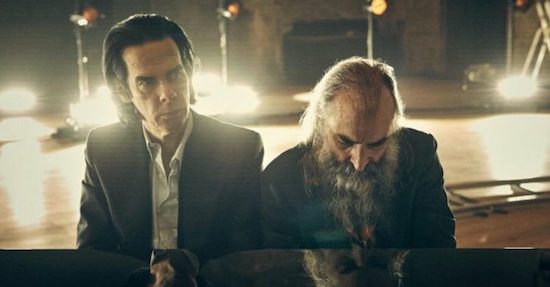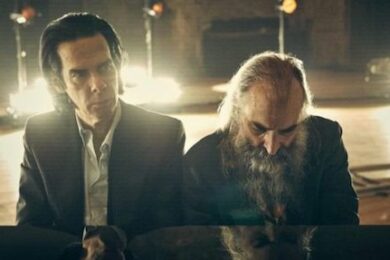Nick Cave doesn’t seem like the kind of man to take government advice to heart, but that’s what he claims to do at the beginning of This Much I Know To Be True – his latest documentary with longtime friend and collaborator Warren Ellis. Granted, he says it as a sort of “fuck you” to a state that hasn’t done a single thing to support the music industry throughout the pandemic, but he also has very much “retrained” as a ceramicist. The film opens with Cave carefully showing off a series of 18 resin moulds he’s working on, which tell the story of the devil from innocence to experience and out the other side. Their titles include: the devil inherits the earth, the devil’s first love, the devil rides to war, the devil forgiven.
“The devil has separated himself from the world through his transgressions," Cave says of the turning point in the tale. "Here is the world operating as normal – rabbits, children, life goes on – and he is contemplating the world.”
Shot by Andrew Dominik (The Assassination of Jesse James by the Coward Robert Ford), This Much I Know To Be True captures Cave and Ellis in a new phase that finds them working more patiently, considering the meaning of things more closely. Cave, for his part, talks about his changing relationship to creativity. These days he’s trying to view himself as “a person, a husband, a father, a friend and citizen who makes music and writes”, as opposed to the other way around. Elsewhere, Ellis mulls over his artistic process, embracing the fact that he has “no sense of form and order” (he says this shortly after the camera pans away from his laptop, on which you can see approximately 1,000 files cluttered on the desktop).
With their friendship and creative relationship placed front and centre of the film, Cave chimes in and says it’s pointless him writing a demo and taking it into the studio, because Ellis’ brain simply doesn’t respond to that way of working. Most of what they make together happens in the moment. “A whole lot of terrible shit happens when me and Warren get into a room,” says Cave, “but there are these moments when it just…” He raises his hands to signify the birth of something magnificent.
That sense of organic magic is palpable on This Much I Know To Be True, which mainly shows Cave and Ellis performing songs from 2019’s Ghosteen and 2021’s Carnage live for the first time – among them “Spinning Song”, “Bright Horses”, “Galleon Ship”, “Hand of God” and “Balcony Man” – flanked by singers and a string quartet. Things are in a constant state of flux, whether it’s the interplay between musicians or the fact that the cameras never rest in one place, or focus on one thing, for too long. When they’re joined by Marianne Faithfull, her delivery is backed by strobe lighting that makes it feel theatrical, like King Lear adapted for a Berlin club. The sound keeps rolling at the end of the film so not even the credits are shown in one-dimensional silence, instead rolling over the domestic noise of people chatting and packing down equipment. It’s the spiritual inverse of 2020’s Idiot Prayer, which saw Cave playing the grand piano alone inside the cavernous and ornate halls of London’s Alexandra Palace.
Above all else, This Much I Know To Be True is about the search for meaning. This provides the foundations of the documentary – and with cinematography by Robbie Ryan (The Favourite, Marriage Story), the film is shot and structured as a work of art in and of itself, rather than acting as a live performance simply captured on camera – but it’s also interrogated in the scenes between the songs. In one scene, Cave talks about his intent behind The Red Hand Files, the site he uses to respond to letters from strangers. He describes it as a “spiritual practice” that appeals to the better part of his nature, since it forces him to take time – often days – to “arrive at a compassionate relationship to the question and to the person who’s writing in”. It’s an antidote to the rush with which we live our lives now, rarely taking the time to sit with the big things and interacting with strangers with a regrettable degree of bad faith (something Cave has found himself on the receiving end of many times).
The main theme of the letters seems to be loss of control over one’s life, with many people asking for advice on how to handle grief, or the dissolution of a marriage, or being let go from a job. These are things everyone has to go through, and yet when they happen to us we have no idea what to do with the upheaval. If there is a distinct ‘point’ This Much I Know To Be True has to make, it comes towards the end when Cave says that, for him, having a sense of meaning about things is more important than happiness. Here he gestures towards the need for an anchor, regardless of what form it takes. For many, it will be his own music with Warren Ellis and The Bad Seeds, and in that regard This Much I Know To Be True responds to the great collective question of the last few years in particular: how do we make sense of what has happened, and how do we move forward?
As a songwriter Cave has always made the personal feel essential, the everyday feel biblical. He is interested in the big questions, which is perhaps why his records “floor” people on the regular, but he knows as well as any of us that there are no answers. There is mostly yearning, and confusion, and feeling bad, and learning to live with it. By way of instruction, This Much I Know To Be True portrays Nick Cave and Warren Ellis as being in constant conversation with each other, their work in constant conversation with itself, and Cave in literal conversation with their fans. As a performance, it gives people the chance to hear songs from the most critically acclaimed albums of their careers for the first time built out into transformative pieces. And as a film, it continues the eternal conversation with their audience, who have spent the last few years in isolation and solitude, inviting us deeper into their world behind the music.




